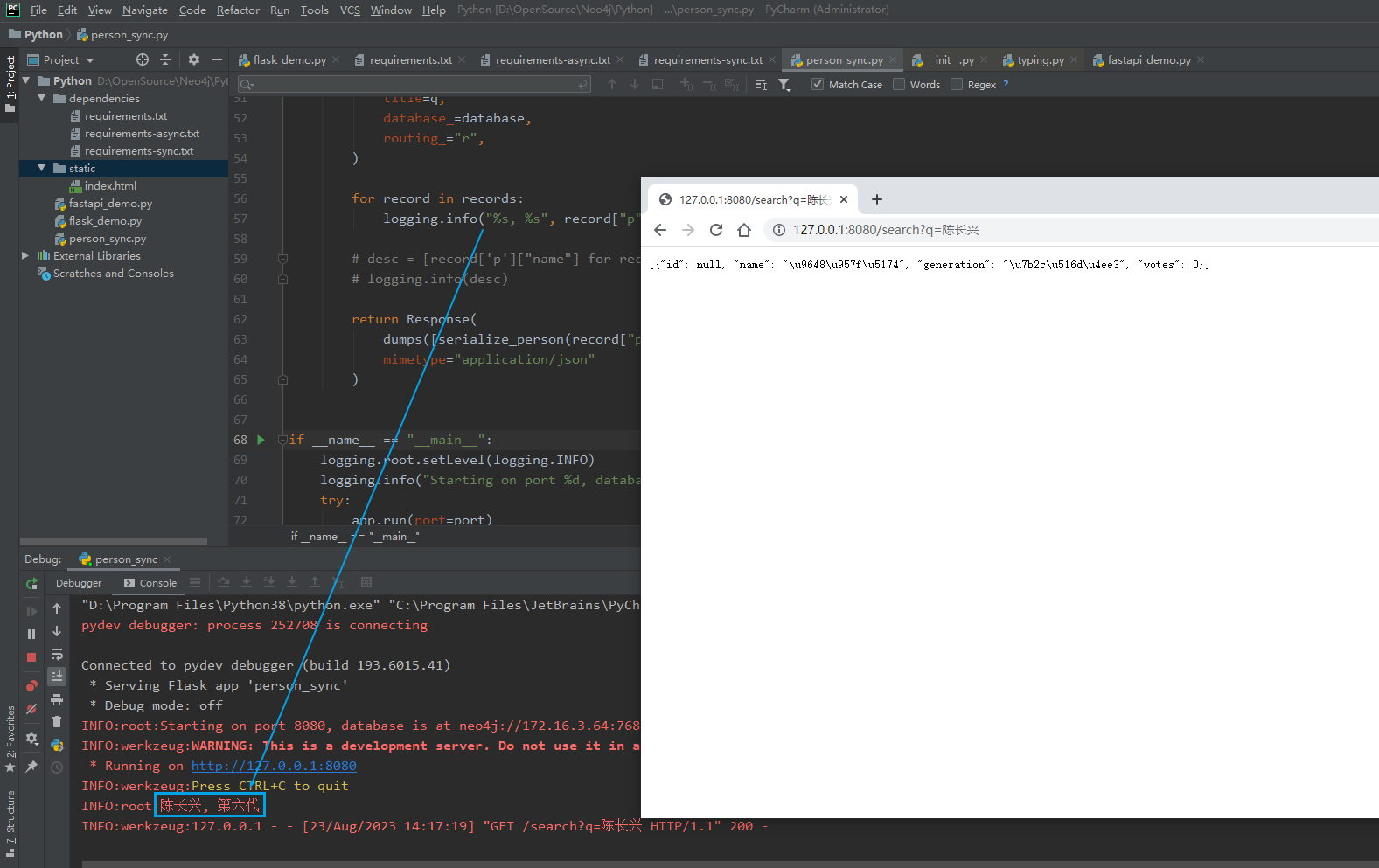数据基于: 知识图谱(Knowledge Graph)- Neo4j 5.10.0 使用 - CQL - 太极拳传承谱系表
这是一个非常简单的web应用程序,它使用我们的Movie图形数据集来提供列表搜索、详细视图和图形可视化。
我们提供了两种不同的方式来运行应用程序:同步和异步(使用asyncio)。
Web framework:
前端:
Neo4j 数据连接: Neo4j Python Driver for Cypher Docs
py2neo 目前不支持 neo4j 5.X 所在使用 Neo4j Driver
Python连接Neo4j工具比较 Neo4j Driver、py2neo
基础依赖:requirements.txt
# common requirements for sync and async example neo4j==5.10.0 typing_extensions==4.7.1复制
同步依赖:requirements-sync.txt
# common requirements -r requirements.txt # sync web framework Flask==2.3.2复制
同步依赖:requirements-async.txt
# common requirements -r requirements.txt # async web framework uvicorn==0.23.2 fastapi==0.101.1复制
同步依赖
D:\OpenSource\Neo4j\Python\dependencies> pip install -r requirements-sync.txt -i https://pypi.tuna.tsinghua.edu.cn/simple复制
异步依赖
D:\OpenSource\Neo4j\Python\dependencies> pip install -r requirements-async.txt -i https://pypi.tuna.tsinghua.edu.cn/simple
复制#!/usr/bin/env python
import logging
import os
from json import dumps
from textwrap import dedent
from typing import cast
import neo4j
from flask import Flask, Response, request
from neo4j import GraphDatabase, basic_auth
from typing_extensions import LiteralString #这边红的波浪线,不用管
app = Flask(__name__, static_url_path="/static/")
# 获取环境变量值,如果没有就返回默认值
url = os.getenv("NEO4J_URI", "neo4j://172.16.3.64:7687")
username = os.getenv("NEO4J_USER", "neo4j")
password = os.getenv("NEO4J_PASSWORD", "password")
neo4j_version = os.getenv("NEO4J_VERSION", "5")
database = os.getenv("NEO4J_DATABASE", "neo4j")
port = int(os.getenv("PORT", 8080))
driver = GraphDatabase.driver(url, auth=basic_auth(username, password))
@app.route("/")
def get_index():
return app.send_static_file("index.html")
def query(q: LiteralString) -> LiteralString:
# this is a safe transform:
# no way for cypher injection by trimming whitespace
# hence, we can safely cast to LiteralString
return cast(LiteralString, dedent(q).strip())
def serialize_person(person):
return {
"id": person["id"],
"name": person["name"],
"generation": person["generation"],
"votes": person.get("votes", 0)
}
@app.route("/search")
def get_search():
try:
q = request.args["q"]
except KeyError:
return []
else:
cql = query("""
MATCH (p:Person) WHERE p.name CONTAINS $name RETURN p
""")
records, _, _ = driver.execute_query(
cql,
name=q, #将参数 q 传给cql 变量
database_=database,
routing_="r",
)
for record in records:
# 打印出 record 属性
logging.info("%s, %s", record["p"]["name"], record["p"]["generation"])
# desc = [record['p']["name"] for record in records]
# logging.info(desc)
return Response(
# WEB 会显示序列化后的 JSON,汉字没有直观显示,属于正常现象
dumps([serialize_person(record["p"]) for record in records]),
mimetype="application/json"
)
if __name__ == "__main__":
logging.root.setLevel(logging.INFO)
logging.info("Starting on port %d, database is at %s", port, url)
try:
app.run(port=port)
finally:
driver.close()
复制http://127.0.0.1:8080/search?q=陈长兴

源码地址:https://gitee.com/VipSoft/VipNeo4j/tree/master/Python
参考:
https://github.com/neo4j-examples/movies-python-bolt
https://neo4j.com/developer/python/